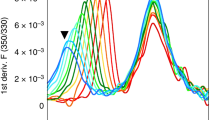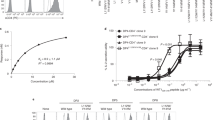Abstract
Mature T lymphocytes are activated by recognition of the combination of foreign protein antigen and membrane products of the major histocompatibility complex (MHC)1. Studies of peptide antigen binding to detergent-solubilized class II MHC molecules (Ia) have established that peptide–Ia interaction occurs in the absence of the T-cell receptor and varies according to allele-specific features of Ia molecules2–4. The residues of immunogenic peptides thus contribute to two largely independent functions — the control of association with Ia molecules and the determination of the specificity of T-cell receptor binding5,6. Two analogous and potentially independent functional sites have been postulated for Ia molecules7— a region that controls binding to peptides and a region that interacts with T-cell receptors. Here we present evidence from functional analysis of recombinant class II molecules that these two postulated functional regions of Ia molecules do exist and can be independently manipulated, consistent with our recent demonstration of the segmental nature of Ia molecule structure-function relationships8.
This is a preview of subscription content, access via your institution
Access options
Subscribe to this journal
Receive 51 print issues and online access
$199.00 per year
only $3.90 per issue
Buy this article
- Purchase on Springer Link
- Instant access to full article PDF
Prices may be subject to local taxes which are calculated during checkout
Similar content being viewed by others
References
Schwartz, R. H. A. Rev. Immun. 3, 237–261 (1985).
Babbitt, B. P., Allen, P. M., Matsueda, G., Haber, E. & Unanue, E. R. Nature 317, 359–361 (1985).
Buus, S., Sette, A., Colon, S. M., Jenis, D. M. & Grey, H. M. Cell 47, 1071–1077 (1986).
Buus, S., Sette, A., Colon, S. M., Miles, C. & Grey, H. M. Science 235, 1353–1358 (1987).
Hansburg, D., Fairwell, T., Schwartz, R. H. & Appella, E. J. Immun. 131, 319–324 (1983).
Allen, P. M. et al. Nature 327, 713–715 (1987).
Heber-Katz, E., Hansburg, D. & Schwartz, R. H. J. molec. Cell. Immun. 1, 3–14 (1983).
Braunstein, N. S. & Germain, R. N. Proc. natn. Acad. Sci. U.S.A. 84, 2921–2925 (1987).
Solinger, A. M., Ultee, M. E., Margoliash, E. & Schwartz, R. H. J. exp. Med. 150, 830–848 (1979).
Carbone, F. R., Fox, B. S., Schwartz, R. H. & Paterson, Y. J. Immun. 138, 1838–1844 (1987).
Heber-Katz, E. et al. J. exp. Med. 155, 1086–1099 (1982).
Hedrick, S. M. et al. Cell 30, 141–152 (1982).
Matis, L. A. et al. J. Immun. 130, 1527–1535 (1983).
Ashwell, J. D. & Schwartz, R. H. Nature 320, 176–179 (1986).
Mengle-Gaw, L. & McDevitt, H. O. Proc. natn. Acad. Sci. U.S.A. 80, 7621–7625 (1983).
Widera, G. & Flavell, R. A. EMBO J. 3, 1221–1225 (1984).
Ronchese, F., Brown, M. A. & Germain, R. N. J. Immun. 139, 629–638 (1987).
Mengle-Gaw, L. & McDevitt, H. O. Proc. natn. Acad. Sci. U.S.A. 82, 2910–2914 (1985).
Miller, J. & Germain, R. N. J. exp. Med. 164, 1478–1489 (1986).
Steinmetz, M. et al. EMBO J. 3, 2995–3003 (1984).
Corradin, G. P. & Harbury, H. A. Biochim. biophys. Acta 221, 489–496 (1970).
Suzuki, G. & Schwartz, R. H. J. Immun. 136, 230–239 (1986).
Author information
Authors and Affiliations
Rights and permissions
About this article
Cite this article
Ronchese, F., Schwartz, R. & Germain, R. Functionally distinct subsites on a class II major histocompatibility complex molecule. Nature 329, 254–256 (1987). https://doi.org/10.1038/329254a0
Received:
Accepted:
Issue Date:
DOI: https://doi.org/10.1038/329254a0
This article is cited by
-
Concentration of MHC class II molecules in lipid rafts facilitates antigen presentation
Nature Immunology (2000)
-
Induction of T-cell anergy by altered T-cell-receptor ligand on live antigen-presenting cells
Nature (1993)
-
MHC class II interaction with CD4 mediated by a region analogous to the MHC class I binding site for CD8
Nature (1992)
-
Mapping T-cell receptor–peptide contacts by variant peptide immunization of single-chain transgenics
Nature (1992)
-
The structural basis of alloreactivity
Immunologic Research (1990)
Comments
By submitting a comment you agree to abide by our Terms and Community Guidelines. If you find something abusive or that does not comply with our terms or guidelines please flag it as inappropriate.



